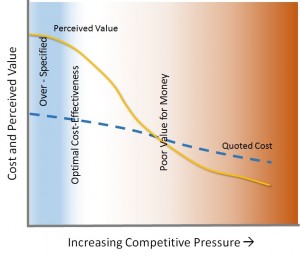Value Alignment
Everyone has their own perception of what constitutes value. It even has an accepted generic formula: Quality/Price. However, in industries where no attempt is made to differentiate offerings, the inevitable result is a race to the bottom where nothing is sacred in the drive to reduce costs. In reality, there comes a point where the “subjective” components of a product or service – service quality, availability, reliability, supplier willingness to address any issues in the project, as examples, are lost completely. Suppliers who will not compromise on these issues are priced out of an increasingly inefficient and perhaps even non-compliant supplier base.
 A tipping point is reached, when the reduction on overall value-for-money drops off faster than the attendant reduction in price. Customers know this very well – PSCM people included. The ideal outcome is often a “just good enough” balance, where the incremental value approaches – but does not reach – a plateau.
A tipping point is reached, when the reduction on overall value-for-money drops off faster than the attendant reduction in price. Customers know this very well – PSCM people included. The ideal outcome is often a “just good enough” balance, where the incremental value approaches – but does not reach – a plateau.
An attempt to sell products and services that are simply over-specified for the purpose will fail; even if one individual in a customer organization likes the idea, they will be over-ridden. So, the task of sales is to identify what the incremental value to the customer is, that will easily justify an increase in price. This means understanding and aligning with the customer’s view of value; your opinion, even if you can prove it by accurately modelling the outcome, is simply irrelevant if the customer doesn’t buy into your calculations. How you decide to do this will depend on your business and your offering. But, whatever it is, the incremental value the customer agrees they will receive has to be significantly greater than the incremental cost of providing it.
Your customer won’t simply agree with you, and they certainly won’t jump to the conclusion you hope they will if they haven’t had a chance to think about it. So, make your model, and be as objective as you can (see Value Types), but you cannot expect to share a proportion of it unless the customer has informally endorsed your view. That means presenting what you believe to be the case, aligned with their priorities and values, to test for acceptance. And remember: all that matters is the incremental value of your differentiated approach presented in the context of the incremental cost of delivering it.

 No2ndPrize
No2ndPrize